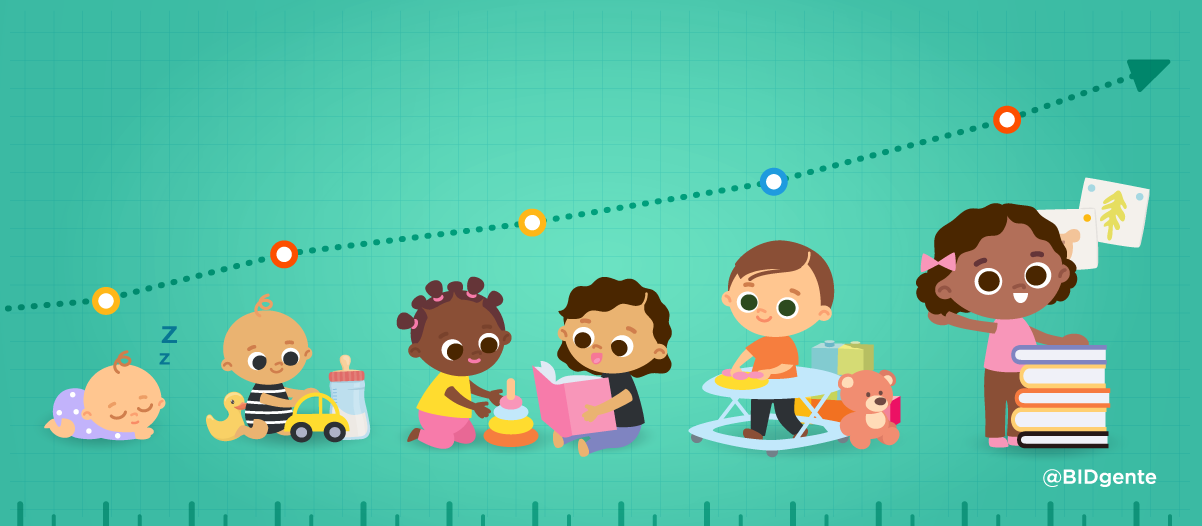Traditionally, economists have focused on how to improve productivity and the ability to generate income by adult workers. But in the last two decades, the percentage of economists who work in the development of our youngest has been growing. The reason? Find out in this article.
For over two decades, an increasing number of economists are working on early childhood development topics. They have been documenting heartbreaking gaps in cognition and language between children living in more versus less vulnerable families. They have been designing, running and evaluating interventions that aim to close such gaps by increasing caregiver knowledge on best caregiving practices—this is, warm, sensitive and stimulating interactions and play—and by promoting them among caregivers in the home and childcare environments.
But why?
Because economists are ultimately interested in poverty alleviation. And human capital accumulation—this is, how skills abilities are formed and accumulated—is key for breaking its intergenerational transmission. For many decades, economists—labor, education and, more recently, development economists—have been studying the lifecycle, from end to beginning, to understand the process of human capital accumulation and thus find the silver bullet to alleviate poverty and reduce inequalities.
- Traditionally, they focused on improving productivity and the ability to generate income among adult workers, therefore, studying labor market programs.
- Later, the focus shifted to the youth and facilitating access to higher education (loans for college education, for example) or reducing engagement in risky behaviors (e.g., drug consumption or unprotected sex).
- Over time, access to secondary school, improving retention rates during school transitions, and education quality (teacher quality, curricular content, and textbooks, etc.) at the secondary and primary levels received increasing attention.
- Eventually, the debate revolved around promoting school readiness and hence access to preschool, preschool quality or how parents interact and invest in their babies became relevant areas of study.
Having gone all the way down the lifecycle, economists now join developmental psychologists and neuroscientists in arguing that the foundations for a healthy and productive life start very early in life and that any deficits in such foundations have long-lasting effects that extend to the next generation.
And how can they help?
Economics is the social science that studies the optimal allocation of scarce resources. This means understanding how ‘economic agents’—firms, producers, consumers, people—make the best possible decisions under the constraints they face. Economics heavily relies on models and math to formalize such a decision-making process and frame it as an optimization problem. This is very powerful as it allows us to simulate the response of agents to changes in policy and can help the policymaker decide if/when/how it is best to intervene. For example, it allows simulating whether taxpayers would reduce their participation in the labor market given an increase in income tax or whether this response would depend on the size of such an increase. When it comes to understanding how parents invest in their children to increase their human capital, economists use a similarly neat tool, the production function, which has a long tradition going back to.
An example from Colombia
The recently published work by Attanasio and colleagues uses very rich data from an experiment that offered, during 18 months, weekly play home visits à la Reach Up to children 12-24 months in poor communities that had been randomly allocated to the treatment group. The high-quality data collected on child development, parental skills and parental investments in materials (toys and books) and in time engaging with their children in stimulating play activities; the random allocation of communities to treatment and control; and the production function setup provided the necessary elements that allowed understanding the mechanisms through which the intervention led to significant gains in children’s cognition and language.
Specifically, the authors found that child development improved because of the increase in parental investments in both play materials and playtime (other than the time spent with the child during the visit). This implies that telling parents about development alone or having had the home visitor interact with the child on her own, without working on strengthening parenting practices, would have been unlikely to benefit children. It also implies that parents do not reduce playtime with their children when they receive this type of interventions—because the home visitor already offers an hour of free play, for example—even if parents with more offspring do invest less as they are more time-constrained! Another two interesting findings, which may help explain persisting inequalities: parents invest more in children they perceive as more able and mothers with higher ability to invest more in their children.
These results have obvious implications for intervention and policy design. The beauty of the approach, however, lies in that it offers a tool, calibrated with real data, that, going forward, can allow simulating the impact of interventions promoting different levels of investment, of different sorts, and among families of diverse socioeconomic status in new contexts, much like a tax simulator.
Are you an economist working in early childhood? Do you know of similar studies? Would it be possible to apply the production function lenses to a program you work on or to data that you have collected? Leave us a comment or mentions as in @BIDgente


Leave a Reply